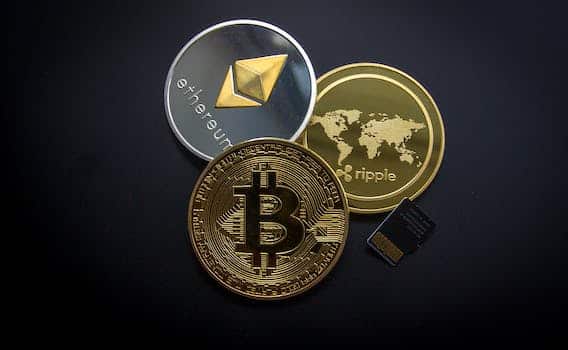Altcoins are a crucial element of the cryptocurrency world. In simple terms, altcoins refer to all cryptocurrencies other than Bitcoin. With the popularity and success of Bitcoin, numerous alternative digital currencies have emerged, each with its unique features and purposes. Altcoins serve as alternatives to Bitcoin, offering different functionalities, protocols, and blockchain technologies. Understanding the concept of altcoins is essential for anyone interested in exploring the vast and evolving landscape of cryptocurrencies.
- 1. Introduction
- 1.1. Definition of Altcoins
- 1.2. Importance of Altcoins in the Cryptocurrency Market
- 1.3. History of Altcoins
- 1.4. Different Types of Altcoins
- 1.5. Altcoins vs. Bitcoin
- 2. Advantages and Disadvantages of Altcoins
- 2.1. Advantages of Altcoins
- 2.2. Disadvantages of Altcoins
- 2.3. Volatility and Risk Factors
- 2.4. Market Adoption and Liquidity
- 2.5. Regulatory Challenges
- 3. Popular Altcoins in the Market
- 3.1. Ethereum (ETH)
- 3.2. Ripple (XRP)
- 3.3. Litecoin (LTC)
- 3.4. Bitcoin Cash (BCH)
- 3.5. Cardano (ADA)
1. Introduction
Altcoins are a significant part of the cryptocurrency market. While Bitcoin is undoubtedly the most well-known cryptocurrency, altcoins represent the numerous alternative digital currencies that have emerged after Bitcoin’s success. The term ‘altcoin’ is a combination of ‘alternative’ and ‘coin,’ referring to any cryptocurrency other than Bitcoin. These altcoins strive to offer unique features, improvements, or variations compared to Bitcoin, catering to specific needs and preferences of cryptocurrency users. With a diverse range of altcoins available today, investors and enthusiasts have numerous options to explore beyond Bitcoin’s dominance.
1.1. Definition of Altcoins
Altcoins, short for alternative coins, refer to any cryptocurrency that is not Bitcoin. While Bitcoin was the first and most well-known cryptocurrency, altcoins have emerged as alternatives to Bitcoin, each with its own unique features and purposes. Altcoins are created using blockchain technology, similar to Bitcoin, but they often have different algorithms, consensus mechanisms, or additional functionalities that set them apart. Some popular altcoins include Ethereum, Ripple, Litecoin, and Bitcoin Cash. These coins offer different advantages and use cases, catering to various needs within the cryptocurrency ecosystem. Altcoins have gained popularity and recognition in the crypto market, contributing to the diversification and expansion of the overall cryptocurrency landscape.
1.2. Importance of Altcoins in the Cryptocurrency Market
Altcoins play a crucial role in the cryptocurrency market. While Bitcoin has established itself as the leading digital currency, altcoins offer a diverse range of options for investors and users. These alternative coins, or altcoins, refer to any cryptocurrency other than Bitcoin. They have gained significant popularity and recognition in recent years due to their unique features and functionalities.
Altcoins provide a means for innovation and experimentation within the cryptocurrency ecosystem. They allow developers to introduce new technologies, improve upon existing blockchain networks, and explore different consensus mechanisms. This level of competition and innovation drives the overall growth and development of the cryptocurrency market.
Moreover, altcoins offer investors a chance to diversify their cryptocurrency holdings. By investing in altcoins, individuals can mitigate the risks associated with relying solely on Bitcoin’s performance. Altcoins often have different use cases, target markets, and underlying technologies, providing investors with a wider range of options to choose from.
Additionally, altcoins contribute to the liquidity of the cryptocurrency market. The presence of multiple altcoins ensures that there are always alternative options for trading and exchanging digital assets. This liquidity plays a vital role in attracting new participants and facilitating seamless transactions within the cryptocurrency ecosystem.
In conclusion, altcoins are essential to the cryptocurrency market as they foster innovation, diversification, and liquidity. Their presence expands the possibilities within the digital currency space and enhances the overall growth and adoption of cryptocurrencies.
1.3. History of Altcoins
Altcoins, also known as alternative coins, are digital currencies that were created as an alternative to Bitcoin, the first and most well-known cryptocurrency. The history of altcoins dates back to the early days of Bitcoin, when several developers started experimenting with creating their own digital currencies. These alternative cryptocurrencies aimed to address some of the limitations and shortcomings of Bitcoin, such as scalability issues or privacy concerns. Over time, the number of altcoins has grown exponentially, with thousands of different cryptocurrencies now in existence. Each altcoin has its own unique features, technologies, and purposes, catering to different needs and preferences within the cryptocurrency community. Some examples of popular altcoins include Ethereum, Ripple, Litecoin, and Dash. The history of altcoins is marked by constant innovation, as developers continue to introduce new ideas and improvements to the world of cryptocurrency.
1.4. Different Types of Altcoins
Altcoins, short for alternative coins, are any form of cryptocurrency other than Bitcoin. While Bitcoin is the most well-known and widely used cryptocurrency, there are thousands of altcoins available in the market. These altcoins serve different purposes and offer various features that differentiate them from Bitcoin. They were introduced as an alternative to Bitcoin, aiming to address its limitations or provide additional functionalities. Some altcoins focus on privacy and anonymity, while others aim to improve transaction speed or scalability. Each altcoin has its unique characteristics and use cases, making the cryptocurrency market diverse and dynamic.
1.5. Altcoins vs. Bitcoin
Altcoins are alternative cryptocurrencies to Bitcoin. While Bitcoin was the first and most well-known cryptocurrency, altcoins have emerged as competitors and alternatives to Bitcoin. Altcoins offer different features and functionalities compared to Bitcoin, making them attractive to investors and users in the cryptocurrency market. This article will explore the differences between altcoins and Bitcoin, highlighting their unique characteristics and the potential advantages they offer.
2. Advantages and Disadvantages of Altcoins
Altcoins, or alternative cryptocurrencies, have gained popularity in the world of cryptocurrency. They offer several advantages and disadvantages compared to traditional cryptocurrencies like Bitcoin. Understanding these pros and cons can help investors make informed decisions.
Advantages of Altcoins:
1. Diversification: Altcoins provide a way to diversify cryptocurrency holdings. By investing in different altcoins, investors can spread their risk and potentially maximize their returns.
2. Innovation: Altcoins often introduce new technologies and features that are not available in traditional cryptocurrencies. This innovation can lead to exciting possibilities and advancements in the cryptocurrency space.
3. Lower entry barriers: Some altcoins have lower entry barriers, meaning they are more affordable to purchase compared to dominant cryptocurrencies like Bitcoin. This allows more people to participate in the cryptocurrency market.
Disadvantages of Altcoins:
1. Volatility: Altcoins tend to be more volatile than established cryptocurrencies. Their prices can experience significant fluctuations, making them riskier investments.
2. Lack of liquidity: Altcoins may have lower trading volumes and liquidity compared to major cryptocurrencies. This can limit the ease of buying and selling altcoins and may result in higher transaction costs.
3. Higher risk of scams: Due to the relative newness and lack of regulation in the altcoin market, there is a higher risk of scams and fraudulent projects. Investors need to be cautious and do thorough research before investing in any altcoin.
In conclusion, altcoins offer diversification, innovation, and lower entry barriers, but they come with higher volatility, lack of liquidity, and increased risk of scams. It is important for investors to carefully consider these advantages and disadvantages before venturing into the world of altcoins.
2.1. Advantages of Altcoins
Altcoins, also known as alternative cryptocurrencies, offer several advantages for investors and users in the cryptocurrency market. These advantages include:
1. Diversification: Altcoins provide an opportunity for diversification within the cryptocurrency portfolio. By investing in different altcoins, investors can spread their risk and potentially increase their chances of gaining higher returns.
2. Innovation: Altcoins often introduce new technologies, features, or improvements to the existing cryptocurrency ecosystem. They serve as a platform for testing and implementing innovative ideas that may eventually be adopted by larger cryptocurrencies like Bitcoin.
3. Lower entry barriers: Unlike Bitcoin, which has a high market price, many altcoins are relatively affordable, making them accessible to a wider range of investors. This lower entry barrier allows individuals with limited funds to participate in the cryptocurrency market.
4. Potential for higher returns: Due to their lower market capitalization and volatility, altcoins have the potential to experience significant price fluctuations. These fluctuations can result in higher returns for investors who successfully navigate the market.
5. Specialized use cases: Some altcoins are designed to serve specific industries or applications. For example, Ethereum enables the development of decentralized applications (DApps) and smart contracts. Altcoins with specialized use cases offer unique opportunities for users and businesses operating within those industries.
While altcoins have their advantages, it’s important to consider the disadvantages as well to make informed investment decisions.
2.2. Disadvantages of Altcoins
Altcoins, or alternative cryptocurrencies, have gained popularity in the cryptocurrency market. While they offer certain advantages, it is important to understand their disadvantages as well.
One major disadvantage of altcoins is their volatility. Unlike established cryptocurrencies like Bitcoin, altcoins often experience significant price fluctuations. This volatility makes altcoin investments riskier and more unpredictable.
Another disadvantage is the lack of wide acceptance. While Bitcoin has gained mainstream recognition and acceptance, many altcoins are not widely accepted as a form of payment. This limits their utility and can make it challenging to use altcoins for everyday transactions.
Additionally, altcoins may face regulatory challenges. As governments and regulatory bodies focus on regulating cryptocurrencies, altcoins may be subject to stricter regulations or even bans. This regulatory uncertainty can impact the value and viability of altcoins.
Furthermore, altcoins are more susceptible to scams and fraudulent activities. Due to the lower market capitalization and liquidity compared to Bitcoin, altcoins can be targeted by scammers who manipulate prices or create fraudulent projects. Investors need to be cautious and conduct thorough research before investing in altcoins.
Lastly, altcoins face the risk of being overshadowed by Bitcoin. As Bitcoin continues to dominate the cryptocurrency market, altcoins may struggle to gain significant attention and adoption. This can affect their long-term value and potential for growth.
Overall, while altcoins offer some advantages, such as potential higher returns and innovative features, they also come with significant disadvantages. It is crucial for investors to carefully assess the risks and drawbacks associated with altcoins before making investment decisions.
2.3. Volatility and Risk Factors
Volatility is a significant risk factor associated with altcoins in the cryptocurrency market. Altcoins, which refer to alternative cryptocurrencies other than Bitcoin, are known for their price fluctuations. The value of altcoins can experience drastic changes within short periods, making them highly volatile assets. This volatility can be attributed to various factors, including market demand, investor sentiment, regulatory changes, and technological advancements.
One of the advantages of altcoins is their potential for high returns. Due to their volatile nature, altcoins can offer opportunities for substantial profits if timed correctly. Investors who are willing to take on the associated risks may benefit from the significant price swings and capitalize on short-term trading strategies.
However, the high volatility of altcoins also poses a considerable risk. The price fluctuations can lead to substantial losses if the market moves against an investor’s position. It requires careful risk management and thorough market analysis to navigate the altcoin market successfully. Additionally, the lack of regulation and oversight in the altcoin space can expose investors to potential scams and fraud. It is crucial to conduct thorough research and exercise caution when investing in altcoins.
In summary, altcoins offer the potential for high returns but come with significant volatility and risk factors. Investors should carefully consider their risk tolerance and conduct thorough market analysis before engaging in altcoin trading.
2.4. Market Adoption and Liquidity
Market adoption and liquidity are crucial factors to consider when evaluating the advantages and disadvantages of altcoins in the cryptocurrency market. Altcoins, which refer to alternative cryptocurrencies other than Bitcoin, have gained significant popularity and have seen varying levels of market adoption.
One of the advantages of altcoins is their potential for high liquidity. Many altcoins are listed on multiple cryptocurrency exchanges, allowing for easy buying and selling. This liquidity can provide investors with more opportunities to trade and potentially profit from price movements.
However, it is important to note that not all altcoins have the same level of market adoption and liquidity. Some altcoins may have limited trading volume and lower liquidity, making it more challenging to buy or sell them at desired prices. This lack of liquidity can result in higher price volatility and increased risk for investors.
Additionally, altcoins may also face challenges in gaining widespread market adoption. While some altcoins have gained significant popularity and acceptance, many others struggle to attract widespread attention and usage. This lack of adoption can limit the utility and value of altcoins, as they may not be widely accepted as a form of payment or store of value.
In conclusion, market adoption and liquidity play a crucial role in determining the advantages and disadvantages of altcoins. High liquidity can provide more trading opportunities, but not all altcoins have the same level of liquidity. Similarly, market adoption varies among altcoins, which can impact their utility and value. Investors should carefully evaluate these factors when considering altcoin investments.
2.5. Regulatory Challenges
Regulatory Challenges for Altcoins
While altcoins offer several advantages in the world of cryptocurrency, they also face a number of regulatory challenges. One of the main issues is the lack of standardized regulations across different jurisdictions. Unlike traditional currencies, altcoins operate on decentralized platforms, making it difficult for governments and regulatory bodies to establish uniform rules and guidelines. This lack of regulation can lead to increased market volatility and potential risks for investors.
Another challenge is the potential for fraudulent activities and scams within the altcoin market. Due to the anonymous nature of transactions and the lack of oversight, altcoins can be susceptible to fraudulent schemes, such as pump-and-dump schemes or initial coin offering (ICO) scams. These fraudulent activities not only harm investors but also tarnish the reputation of the entire altcoin market.
Furthermore, the rapid evolution of altcoins and the emergence of new technologies pose additional challenges for regulators. Cryptocurrency innovations such as smart contracts and decentralized finance (DeFi) platforms introduce complex legal and regulatory considerations that require careful examination. Regulators must keep up with the constantly evolving altcoin landscape to ensure consumer protection and prevent potential systemic risks.
Despite these regulatory challenges, altcoins offer certain advantages over traditional cryptocurrencies like Bitcoin. It is important for regulators to strike a balance between fostering innovation and protecting investors. By establishing transparent and comprehensive regulations, governments can provide a more secure environment for altcoin adoption and facilitate the growth of this emerging sector.
3. Popular Altcoins in the Market
Altcoins, also known as alternative coins, are cryptocurrencies that were launched after the success of Bitcoin. While Bitcoin remains the most popular and widely recognized cryptocurrency, there are numerous altcoins that have gained significant attention and adoption in the market.
Here are some of the popular altcoins in the cryptocurrency market:
1. Ethereum (ETH): Ethereum is a decentralized platform that enables the development of smart contracts and decentralized applications (DApps). It has gained immense popularity due to its advanced features and potential for innovation.
2. Ripple (XRP): Ripple is a digital payment protocol and cryptocurrency that aims to enable fast, low-cost international money transfers. It has been embraced by major financial institutions and has a strong presence in the banking industry.
3. Litecoin (LTC): Created by Charlie Lee, a former Google engineer, Litecoin is often referred to as the silver to Bitcoin’s gold. It offers faster transaction confirmation times and a different hashing algorithm.
4. Bitcoin Cash (BCH): Bitcoin Cash is a cryptocurrency that emerged as a result of a hard fork from the original Bitcoin. It aims to be a scalable and efficient digital currency for everyday transactions.
5. Cardano (ADA): Cardano is a blockchain platform that aims to provide a more secure and sustainable platform for the development of decentralized applications and smart contracts. It places a strong emphasis on research and academic rigor.
6. Polkadot (DOT): Polkadot is a multi-chain platform that allows different blockchains to interoperate and share information. It aims to enable a decentralized internet where multiple blockchains can seamlessly communicate with each other.
These are just a few examples of the popular altcoins in the market. Each altcoin has its own unique features and value proposition, catering to different use cases and industries. It is important to conduct thorough research and due diligence before investing in any altcoin.
3.1. Ethereum (ETH)
Ethereum (ETH) is one of the most popular altcoins in the cryptocurrency market. As the second-largest cryptocurrency by market capitalization, Ethereum has gained significant attention and adoption since its launch in 2015. Created by Vitalik Buterin, Ethereum is not just a digital currency but also a platform that enables developers to build and deploy decentralized applications (DApps). This unique feature has made Ethereum a favorite among developers and investors alike.
One of the key innovations brought by Ethereum is the concept of smart contracts. These self-executing contracts automate the execution of predefined conditions without the need for intermediaries. This opens up a world of possibilities for various industries, including finance, supply chain management, gaming, and more.
ETH, the native cryptocurrency of the Ethereum network, is used as a fuel to power transactions and smart contracts on the platform. It is also tradable on numerous cryptocurrency exchanges, making it easily accessible to investors and traders.
Ethereum’s popularity stems from its ability to address the limitations of the Bitcoin network. While Bitcoin primarily focuses on peer-to-peer digital payments, Ethereum expands on that vision by introducing programmable functionalities. This has led to the development of numerous decentralized applications and the emergence of the booming decentralized finance (DeFi) ecosystem.
Despite facing scalability challenges and competition from other altcoins, Ethereum remains a dominant force in the cryptocurrency market. The upcoming Ethereum 2.0 upgrade aims to address scalability issues and enhance the network’s overall performance, further solidifying its position.
In conclusion, Ethereum (ETH) is a widely recognized altcoin that has revolutionized the blockchain industry with its smart contract capabilities. Its popularity among developers and investors showcases its potential for innovation and growth in the crypto market.
3.2. Ripple (XRP)
Ripple (XRP) is one of the most popular altcoins in the cryptocurrency market. As the native digital currency of the Ripple payment protocol, XRP aims to facilitate fast and secure cross-border transactions. Unlike Bitcoin and other cryptocurrencies, Ripple operates on a centralized network, making it more efficient and scalable. XRP has gained significant traction in the banking and financial industry due to its low transaction fees and quick settlement times. With its innovative technology and partnerships with major institutions, Ripple has emerged as a promising altcoin in the ever-evolving cryptocurrency market.
3.3. Litecoin (LTC)
Litecoin (LTC) is one of the most popular altcoins in the cryptocurrency market. Launched in 2011 by Charlie Lee, a former Google engineer, Litecoin was designed to be a peer-to-peer digital currency that offers faster transaction confirmations and a different hashing algorithm compared to Bitcoin. With its strong focus on speed and efficiency, Litecoin has gained a significant following among cryptocurrency enthusiasts.
One of the key features of Litecoin is its ability to process transactions more quickly than Bitcoin. While Bitcoin takes around 10 minutes to confirm a transaction, Litecoin can do it in just 2.5 minutes. This makes Litecoin a preferred choice for users who value faster transaction times.
Additionally, Litecoin uses a different hashing algorithm called Scrypt, which makes it more accessible for individual miners. Unlike Bitcoin’s SHA-256 algorithm that requires expensive ASIC mining hardware, Litecoin mining can be done with consumer-grade CPUs and GPUs, allowing more people to participate in the mining process.
Litecoin also offers a larger supply cap compared to Bitcoin. While Bitcoin has a maximum supply of 21 million coins, Litecoin has a cap of 84 million coins. This larger supply ensures that Litecoin remains more abundant and affordable, making it attractive for everyday transactions.
In terms of adoption, Litecoin has gained widespread acceptance among merchants and payment processors. Many online and offline businesses now accept Litecoin as a form of payment, further solidifying its position as a popular altcoin.
Overall, Litecoin has established itself as a prominent altcoin in the cryptocurrency market. With its focus on speed, efficiency, and wider accessibility, Litecoin offers a unique value proposition for users seeking an alternative to Bitcoin.
3.4. Bitcoin Cash (BCH)
Bitcoin Cash (BCH) is one of the popular altcoins in the cryptocurrency market. It was created in 2017 as a result of a hard fork from the original Bitcoin (BTC). Bitcoin Cash aims to offer faster and cheaper transactions compared to Bitcoin.
One of the key features of Bitcoin Cash is its larger block size, which allows for more transactions to be processed in each block. This helps to reduce congestion on the network and lower transaction fees. Additionally, Bitcoin Cash supports smart contracts and decentralized applications, similar to Ethereum.
Bitcoin Cash has gained a significant following and has been widely adopted by merchants and individuals looking for an alternative cryptocurrency to Bitcoin. Its ability to handle more transactions quickly and at a lower cost has made it attractive for everyday use.
However, Bitcoin Cash has also faced criticism and controversy within the cryptocurrency community. Some argue that its larger block size compromises decentralization and security, while others believe it lacks the same level of network effects and recognition as Bitcoin.
Overall, Bitcoin Cash is an important altcoin in the market that offers a different approach to digital payments compared to traditional cryptocurrencies like Bitcoin. Its ability to provide faster and cheaper transactions has made it a popular choice for many users.
3.5. Cardano (ADA)
Cardano (ADA) is one of the popular altcoins in the cryptocurrency market. It was created in 2017 by Charles Hoskinson, one of the co-founders of Ethereum. Cardano aims to provide a more secure and scalable platform for the development of decentralized applications and smart contracts.
One of the key features of Cardano is its use of a unique proof-of-stake algorithm called Ouroboros. This algorithm ensures the security and efficiency of the network by involving coin holders in the consensus process.
Cardano also emphasizes a scientific approach to its development, relying on peer-reviewed research and academic collaborations. This focus on rigorous research and testing sets Cardano apart from many other altcoins in the market.
With a strong development team and a growing community of supporters, Cardano has gained significant attention in the cryptocurrency space. Its native cryptocurrency, ADA, is widely traded on various exchanges and has shown promising growth potential.
As with any altcoin investment, it is important to conduct thorough research and analysis before considering investing in Cardano or any other altcoin. However, Cardano’s unique features and strong development roadmap make it an altcoin worth keeping an eye on.
Conclusion
In conclusion, altcoins are alternative cryptocurrencies to Bitcoin that have emerged in the cryptocurrency market. They offer various features and functionalities that differentiate them from Bitcoin, such as improved privacy, faster transactions, and enhanced security. Altcoins provide investors with alternative options for diversifying their cryptocurrency portfolios and exploring different blockchain technologies. As the cryptocurrency market continues to evolve, it is important to stay informed about the latest developments and potential investment opportunities in altcoins.





